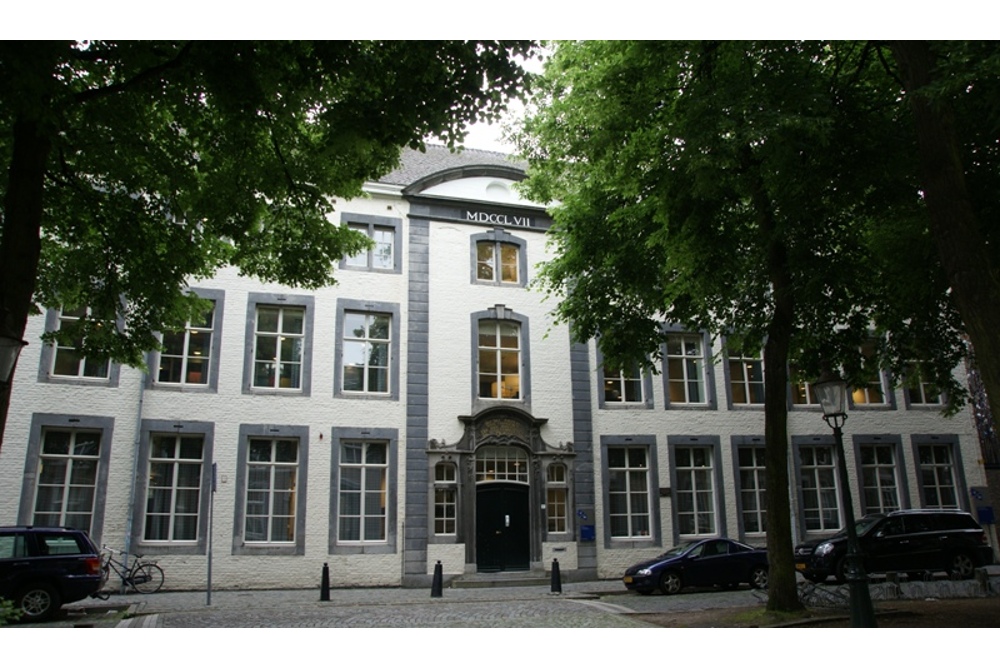Former Camp Political Prisoners "Camp de Grote Looier"
Camp Political Prisoners Maastricht in Maastricht (Limburg) was a detention and residential camp from September 1944 to approximately 1951. "De Grote Looier" (name used by the residents of Maastricht) became infamous for its overcrowding.
At the end of 1944, this former almshouse and military hospital in Maastricht housed approximately 1400 detainees and at its peak approximately 2,600 detainees at a maximum capacity for 700 people.
In January 1945, a large group of NSB members guarded by the Sittard Civil Guard would be transferred from SIttard to Maastricht.
In January 1945, Mr. C. van Oppen also published an article in a local newspaper Veritas with the headline "Dachau in Maastricht?" about what took place behind the walls at the Grote Looierstraat and thus opened a book about the camp. One of the things he mentioned is that there is only a small washing facility with 12 taps for the 1400 prisoners present (for use by both men and women).
In March 1945, the Military Commission in the Province of Limburg led by Lt-Colonel C.W.A. Schurman, in response to complaints about the conditions among political prisoners in the camp, instructed a committee to conduct an investigation. This committee was led by chairman W Hustinx (vice-president at the District Court of Maastricht) with the following members: J. Steegmans (Pastor of the Parish of St. Pieter and Chaplain in the Political Prisoners Camp), H.P.J. Koenen (doctor and deputy Public Health Inspector), E.A. Schoon (lawyer-attorney) and secretary C. Paulussen (lawyer-attorney).
One of the prisoners here was the infamous war criminal Francois Hubert Jaegers, who had handed over several people to the Gestapo during the war by pretending to be in hiding. He managed to escape from the authorities here in October 1945. Later the death penalty would be demanded against him by Baron van Voorst tot Voorst. Ultimately, he would be sentenced to 15 years in prison in 1946. The court considered it proven that he was a confidential counselor of the S.D. at the time of the occupation. worked and lent himself to practicing the profession as an agent provocateur.
Nowadays the building is a national monument and is part of the University of Maastricht (UM) and is used, among other things, as a university library.
Do you have more information about this location? Inform us!
Source
- Text: R. Bronkhorst (2024)
- Photos: Otter
- Veritas, 1945, C. van Oppen - "Dachau in Maastricht?"
- Eindhovens Dagblad, 14-03-1945
- Advertentieblad voor Limburg, 17-03-1945
- Gazet van Limburg, 04-10-1945
- Dagblad de Limburger - ‘Dachau in Maastricht?’ Strafkampen na de bevrijding toneel van wraakacties.
- Oorlogsbronnen.nl
Nearby
Museum
Point of interest
- Regional Quarter Nationale Jeugdstorm - Maastricht
- NSB District Office Limburg - Maastricht
- Office Heerbankwartier VII WA - Maastricht
Monument
- Memorial Deceased French Refugees - Maastricht
- Memorial in City Wall Maastricht - Maastricht
- Memorial Nicolas Beaurieux - Maastricht
Cemetery
- Dutch War Grave Roman Catholic Cemetery Sint Pieter Maastricht - Maastricht
- Belgian War Graves General Cemetery Maastricht - Maastricht
- Dutch War Graves General Cemetery Maastricht - Maastricht
Remembrance Stone
- Stumbling Stone Sint Pieterstraat 2 - Maastricht
- Stumbling Stone Lenculenstraat 9 - Maastricht
- Stumbling Stones Maastrichter Heidenstraat 3 - Maastricht
Fortification
- Fort St. Pieter - Maastricht
- S3-casemate Maastricht - Maastricht
- S3-Casemate Maastricht - Maastricht




